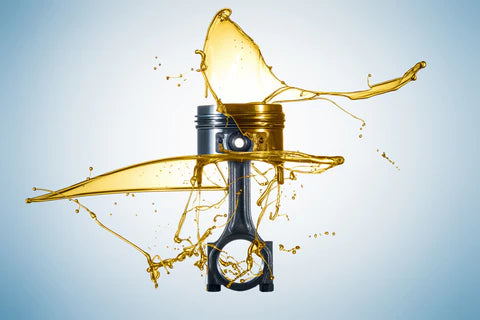Add description, images, menus and links to your mega menu
A column with no settings can be used as a spacer
Link to your collections, sales and even external links
Add up to five columns
Add description, images, menus and links to your mega menu
A column with no settings can be used as a spacer
Link to your collections, sales and even external links
Add up to five columns
FORMULATING THE BEST ENGINE OILS WITH TORCO: A SCIENTIFIC LOOK
%月 %日, %年 3 读

Formulating high-quality engine oils and racing engine oils involves an intricate process of selecting the right base oils and blending them with the perfect combination of additives. It is the precise science of formulation that we will discuss in this blog post, showing you how top-tier engine oils like Torco SR-1 and SR-1R are engineered.
THE POWER OF SYNTHETIC OILS
Synthetic base oil stocks have distinguished themselves as the preferred choice for most high-performance applications. The synthetic base stocks we will discuss are Group III, Group III+, Polyalphaolefins (PAO), Metallocene Polyalphaolefins (mPAO), Alkylated Naphthalene (AN), and Polyol Esters.
These synthetic lubricants offer numerous advantages over traditional mineral oil base stocks. They provide excellent oxidative and thermal stability, contributing to their longevity. They contain no inherent contaminants that could expedite corrosion or acid formation. Moreover, they can enhance the performance of semi- or full-synthetic oils in various applications.
Additionally, synthetic lubricants like mPAO offer superior performance in high-temperature applications, boosting High-Temperature High-Shear (HTHS) viscosity at low treat rates, providing improved protection for engine components. ANs provides a unique combination of benefits like improved lubricity and cleanliness, while Polyol Esters are the default choice for racing oils. They offer better thermal stability, lower pour points, and lower foaming compared to mineral base stocks.
In 2015, with the demand for even higher performance lubricants, the industry introduced Group III+ base oils. These are an upgrade to Group III oils, offering a Very High Viscosity Index (VHVI) in the range of 130-140. This allows lubricants made from Group III+ base oils to maintain their viscosity and lubricating properties even under more extreme temperature variations, making them ideal for top-tier lubricants.
ENGINE OIL ADDITIVES: THE ART OF FORMULATING ENGINE OIL
The formulation of engine oil is a complex process that involves a deep understanding of various additives and their roles. These additives are used in carefully balanced combinations to ensure optimal performance and longevity of your engine.
Detergents and dispersants are used to keep the engine clean and reduce deposit buildup, while oxidation inhibitors prevent the oil from oxidizing. Corrosion and rust inhibitors protect the engine's metal components from corrosion and rust. Anti-wear additives are used to minimize direct metal-to-metal contact, and viscosity modifiers ensure consistent performance under a wide range of operating conditions.
Antifoaming agents are used to alter the surface tension of the oil to promote the rapid breakup of foam bubbles. Pour point depressants lower the temperature at which the oil becomes too thick to flow, and friction modifiers reduce friction between moving parts, improving fuel efficiency and reducing wear.
Understanding the role of these additives is crucial in the formulation of high-quality engine oils. Each additive plays an integral part in ensuring that the oil performs optimally under various operating conditions, protecting the engine from wear and tear, and extending its life.

PUTTING IT ALL TOGETHER: THE COMPLETE PROCESS
-
Selection of Base Oils and Additives: The first step involves selecting the appropriate base oils and additives. The choice of base oils and additives is determined by the desired properties of the finished fluid, such as its viscosity, thermal stability, and resistance to oxidation.
- Blending: The base oils and additives are then mixed together in a blending tank. The mixing process must be carefully controlled to ensure that the additives are evenly distributed throughout the base oil.
- Quality Control: After the blending process, the finished fluid undergoes a series of quality control tests. These tests check for various properties such as viscosity, oxidation stability, and cleanliness. The fluid must meet all the required specifications before it can continue to the next step.
- Filtration: The finished fluid is then filtered to remove any impurities or contaminants. This step is crucial for maintaining the cleanliness of the fluid.
- Packaging: Once the fluid has passed all the quality control tests and has been filtered, it is ready to be packaged and distributed
Conclusion
Crafting high-quality oils involves a precise blend of science and artistry. The careful selection of synthetic base oils like PAO, mPAO, Alkylated Naphthalene, and Polyol Esters, coupled with Group III and Group III+ base oils, provide a strong foundation. The meticulously calculated addition of various additives, each serving a specific purpose, then transforms this base into a lubricant capable of exceptional performance.
We have been working together with Nimbus Motorsports, our distributor in the UK to develop a series of education blog posts highlighting the benefits of our SR-1 and SR1-R motor oils.
Subscribe
Sign up to get the latest on sales, new releases and more …

